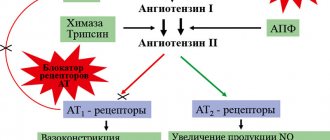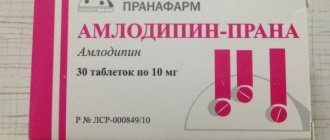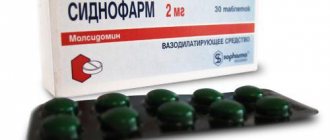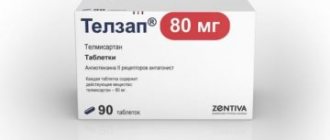Captopril-AKOS is a drug (tablets) that belongs to the pharmacological group of drugs that affect the renin-angiotensin system. Important features of the drug from the instructions for use:
How to dissolve vascular plaques, normalize blood circulation, blood pressure and forget the way to the pharmacy
- Sold only with a doctor's prescription
- During pregnancy: contraindicated
- When breastfeeding: contraindicated
- In childhood: contraindicated
- For liver dysfunction: with caution
- If renal function is impaired: with caution
- In old age: with caution
Release form and composition
The drug is available in the form of tablets: flat-cylindrical, chamfered, almost white or white in color, have a characteristic odor, light marbling is allowed, tablets at a dosage of 50 mg are marked with a separating line (dosage 25 mg: 10 or 25 pieces in blister packs , in a cardboard pack 1, 2, 3 or 4 packs; dosage 50 mg: 10 or 20 pieces in blister packs, in a cardboard pack 1, 2, 3, 4 or 5 packs; 10, 20, 30, 40 , 50, 60, 80 or 100 pieces in polymer cans, 1 can in a cardboard pack; each pack also contains instructions for the use of Captopril-AKOS).
1 tablet contains:
- active ingredient: captopril (in terms of dry weight) – 25 or 50 mg;
- auxiliary components: dosage 25 mg – corn starch, milk sugar, magnesium stearate, talc; dosage 50 mg – lactose monohydrate (milk sugar), colloidal silicon dioxide (Aerosil), microcrystalline cellulose, crospovidone (Kollidon CL-M, Kollidon CL), magnesium stearate, talc.
general information
What is Captopril Akos? This is an antihypertensive drug from the group of ACE inhibitors. It is produced by the domestic pharmaceutical company. The medicine is prescribed for high blood pressure due to various cardiac pathologies.
Release form, cost
The drug is available in the form of tablets that contain different amounts of the active ingredient - 12.5, 25 or 50 mg. The tablets are packaged in plastic blisters of 10 pieces. In total, a cardboard box can contain 20 or 40 tablets.
This is a very cheap drug. The cost of the medication depends on the content of the active substance in 1 tablet and their quantity in the package. So, for 20 pieces of 25 mg you need to pay about 10 rubles, for 40 of the same tablets - from 18 to 23 rubles.
Components, action
The medicine contains the active ingredient - captopril. This substance is classified as an ACE inhibitor (angiotensin-converting enzyme). It affects the body in 2 directions:
- Reducing the amount of angiotensin in the blood plasma. This substance is involved in the pathogenesis of arterial hypertension because it has the ability to:
contract blood vessels, which leads to a narrowing of their lumen;- increases the synthesis of cytosines, which destroy kidney and heart cells.
increase the concentration of the hormone aldosterone, which negatively affects cardiac activity and increases the volume of blood ejection;
Due to a decrease in its concentration in the blood, a decrease in blood pressure and an improvement in blood supply to the heart and other organs are observed.
ACE inhibitors also help with blood pressure by reducing overall resistance in the peripheral and pulmonary vessels.
Additionally, the composition includes forming substances - talc, lactose, magnesium stearate, starch and others. They perform an auxiliary function.
Properties
What beneficial properties does the drug have? They manifest themselves in the following effects:
decreased blood pressure;- increasing minute blood volume and exercise tolerance;
- reducing hypertrophy of the cardiac muscle of the left ventricle, slowing its dilatation;
- prevention of the development of heart failure.
The medicine can also reduce vascular tone in the renal structures. At the same time, there is an improvement in intrarenal blood circulation, and the risk of diabetic nephropathy is reduced.
Pharmacological properties
Pharmacodynamics
Captopril-AKOS is an antihypertensive drug, the mechanism of action of which is determined by the properties of the active substance – captopril. Captopril is a first generation ACE inhibitor containing an SH group (sulfhydryl group). By inhibiting ACE, it reduces the conversion of angiotensin I to angiotensin II and eliminates its vasoconstrictor effect on venous and arterial vessels. A decrease in the level of angiotensin II promotes a secondary increase in plasma renin activity, causing a direct decrease in the secretion of aldosterone by the adrenal cortex. This leads to a decrease in total peripheral vascular resistance (TPVR) and blood pressure (BP), resistance in the pulmonary vessels, and a decrease in pre- and afterload on the heart. The cardiac output and tolerance to physical activity increases.
Under the influence of captopril, arteries dilate more than veins. Also, taking Captopril-AKOS leads to an increase in prostaglandin synthesis and a decrease in bradykinin degradation.
The hypotensive effect of captopril does not depend on plasma renin activity. Its effect on the tissue renin-angiotensin-aldosterone system (RAAS) causes a decrease in blood pressure with normal and reduced hormone activity.
Captopril enhances coronary and renal blood flow and improves blood supply to ischemic myocardium. Its long-term use causes a decrease in the severity of myocardial hypertrophy and the walls of resistive arteries, prevents the progression of heart failure, and inhibits the development of left ventricular dilatation.
Taking Captopril-AKOS leads to a decrease in platelet aggregation, and in heart failure - to a decrease in the content of sodium ions.
By reducing the tone of the efferent arterioles of the glomeruli of the kidneys, it helps improve intraglomerular hemodynamics and prevents the appearance of diabetic nephropathy.
In a daily dose of 50 mg, captopril exhibits angioprotective properties in relation to microvasculature vessels. In patients with diabetic nephroangiopathy, it helps to slow down the progression of chronic renal failure.
Unlike direct vasodilators, such as hydralazine and minoxidil, a decrease in blood pressure while taking Captopril-AKOS is not accompanied by reflex tachycardia and helps reduce myocardial oxygen demand. Adequate doses of captopril in patients with heart failure do not affect blood pressure.
After oral administration, the maximum decrease in blood pressure occurs within 1–1.5 hours. The duration of the hypotensive effect depends on the dose taken; it reaches optimal values after several weeks of therapy.
Do not abruptly stop taking captopril; this can lead to a significant increase in blood pressure.
Pharmacokinetics
After oral administration, approximately 75% of the dose of Captopril-AKOS is rapidly absorbed. Concomitant food intake reduces the absorption of captopril by 30–40%. During the initial passage through the liver, 35–40% of the active substance is biotransformed. The maximum concentration (Cmax) in blood plasma is reached within 0.5–1.5 hours and is 114 ng/ml.
Binding to blood plasma proteins is 25–30% (mainly with albumin).
Crosses the blood-brain and placental barriers in small quantities (less than 1%). Up to 0.002% of the dose taken is secreted into breast milk.
Captopril is metabolized in the liver to form pharmacologically inactive metabolites - captopril disulfide dimer and captopril cysteine sulfide.
The half-life (T1/2) of captopril is approximately 2–3 hours. About 95% of the dose taken is excreted through the kidneys during the first 24 hours (including 40–50% unchanged).
In chronic renal failure, the drug accumulates; T1/2 can range from 3.5 to 32 hours. Patients with impaired renal function should reduce the single dose and/or increase the interval between doses of Captopril-AKOS.
pharmachologic effect
Captopril is a drug from the pharmacological group of ACE inhibitors. Its effectiveness is based on the suppression of enzyme activity, which ensures the conversion of angiothesin I to angiothesin II. This feature allows the blood vessels to maintain their dilated state and, as a result, stabilize blood pressure.
Expansion of the lumen of blood vessels increases the threshold of tolerance to emotional and physical stress, by reducing the load on the heart muscle. Moreover, the active substance does not retain fluid, freeing the patient from additional use of diuretics. This property gives an advantage when choosing an antihypertensive drug.
Contraindications
Absolute:
- severe renal dysfunction, bilateral renal artery stenosis, stenosis of a single kidney with progressive azotemia, refractory hyperkalemia, primary hyperaldosteronism, condition after kidney transplantation;
- severe liver dysfunction;
- simultaneous use of aliskiren and aliskiren-containing drugs in patients with type 2 diabetes mellitus or patients with impaired renal function with creatinine clearance (CC) less than 60 ml/min;
- lactose intolerance, glucose-galactose malabsorption syndrome or lactase deficiency;
- pregnancy period;
- breast-feeding;
- age under 18 years;
- hereditary and/or idiopathic angioedema due to previous therapy with ACE inhibitors (including medical history);
- hypersensitivity to other ACE inhibitors, including history;
- individual intolerance to the components of the drug.
Captopril-AKOS tablets should be prescribed with caution for hypertrophic obstructive cardiomyopathy, coronary heart disease, mitral stenosis, aortic stenosis and similar changes that impede the outflow of blood from the left ventricle of the heart; for renovascular hypertension, chronic renal failure, systemic lupus erythematosus, scleroderma or other connective tissue diseases; with suppression of bone marrow hematopoiesis, cerebrovascular pathologies, diabetes mellitus, hyperkalemia, liver dysfunction, following a diet with limited salt, hemodialysis, diarrhea, vomiting or other conditions that cause a decrease in circulating blood volume; during surgery or general anesthesia, hemodialysis using high-flow membranes (including polyacrylonitrile high-flow membranes AN69), concomitant desensitization therapy, low-density lipoprotein (LDL) apheresis; in combination with potassium-sparing diuretics, potassium preparations, potassium-containing salt substitutes, lithium preparations; patients of the Negroid race, in old age.
Indications for use, restrictions
This medication has special indications. Among them:
persistent increase in blood pressure (hypertension);- symptoms of heart failure;
- cardiomyopathic pathologies;
- post-infarction condition (when the functioning of the left ventricle deteriorates);
- diabetic nephropathy or its prevention in patients with diabetes mellitus or renal failure.
The medicine can be used alone or as part of combination therapy (for example, for chronic heart failure).
In some conditions, taking the drug is not recommended. Contraindications to its use are:
- individual intolerance to components;
- the presence of autoimmune diseases (scleroderma);
angioedema (especially if it developed after taking any ACE inhibitors);- narrowing of the lumen of the aorta and renal arteries;
- disturbances in the process of bone marrow hematopoiesis;
- cardiovascular or cerebrovascular pathologies;
- serious digestive disorders;
- period of bearing a child;
- lactation period.
The medicine is prescribed with extreme caution to elderly people, children before reaching adulthood, and also after undergoing surgery, which provoked the development of hypotension.
Captopril-AKOS, instructions for use: method and dosage
Captopril-AKOS tablets are taken orally 1 hour before meals.
The dose is selected individually.
To select the dose at the initial stage of therapy, it is necessary to use captopril tablets from other manufacturers, 12.5 mg with a dividing line or 25 mg with a cross line.
Recommended dosage:
- arterial hypertension: initial dose – 12.5 mg 2 times a day. During the first hour after taking the first dose, careful monitoring of the patient's condition is necessary for tolerability of Captopril-AKOS. If arterial hypotension develops, the patient should take a horizontal position with legs elevated. This reaction to the first dose is not a reason to discontinue therapy. In the absence of sufficient clinical effect, the dose is gradually increased, maintaining an interval of 14–28 days, until the optimal effect is achieved. The maintenance dose for mild to moderate arterial hypertension is usually 25 mg 2 times a day, the maximum daily dose is 100 mg (50 mg 2 times a day). The maximum daily dose for severe arterial hypertension is 150 mg (50 mg 3 times a day);
- chronic heart failure (as part of combination therapy with diuretics and/or cardiac glycosides; before prescribing captopril, the diuretic is discontinued or its dose is reduced to avoid an excessive decrease in blood pressure): initial dose - 6.25 mg 3 times a day. If necessary, to achieve the desired effect, the dose is increased gradually, maintaining an interval of at least 14 days. The maintenance dose is usually 25 mg 2-3 times a day, the maximum daily dose is 150 mg (50 mg 3 times a day). To achieve a sustainable effect of Captopril-AKOS when symptomatic arterial hypotension occurs, the doses of concomitantly prescribed diuretics and/or other vasodilators can be reduced;
- dysfunction of the left ventricle after myocardial infarction: if the patient’s condition is clinically stable, the drug can be started 3 days after myocardial infarction. The initial dose is 6.25 mg 1 time per day. If necessary, the daily dose is gradually increased, taking into account the tolerability of Captopril-AKOS, to 75 mg, dividing it into 2-3 doses. The maximum daily dose is 150 mg (50 mg 3 times a day). If arterial hypotension develops, the dose can be reduced, but with subsequent attempts to use 150 mg of captopril per day, the tolerability of the drug should be taken into account;
- diabetic nephropathy: 75–100 mg per day, divided into 2–3 doses. The dose of Captopril-AKOS for insulin-dependent diabetes (type 1) with microalbuminuria (albumin secretion 30–300 mg per day) should be 50 mg 2 times a day, with a total protein clearance of more than 500 mg per day - 25 mg 3 times a day .
For moderate renal dysfunction (creatinine clearance 30 ml/min and above), Captopril-AKOS can be prescribed in a daily dose of 75–100 mg.
In case of severe renal impairment (creatinine clearance less than 30 ml/min), the initial daily dose should not exceed 12.5 mg. If necessary, the dose can be gradually increased over fairly long intervals, but the maintenance dose should be less than the usual dose used to treat hypertension.
It is possible to additionally prescribe loop diuretics, but not thiazide diuretics.
Correction of the dosage regimen in case of impaired renal function should be made taking into account the patient’s CK indicator in the following accordance:
- CC 40 ml/min: initial daily dose – 25–50 mg, maximum daily dose – 150 mg;
- CC 21–40 ml/min: initial daily dose – 25 mg, maximum daily dose – 100 mg;
- CC 10–20 ml/min: initial daily dose – 12.5 mg, maximum daily dose – 75 mg;
- CC less than 10 ml/min: initial daily dose – 6.25 mg, maximum daily dose – 37.5 mg.
The starting dose for elderly patients is 6.25 mg 2 times a day. This dosage regimen prevents renal dysfunction, so it is considered optimal for a maintenance dose. It is recommended to adjust the dose of Captopril-AKOS regularly taking into account the patient's therapeutic response, maintaining it at the lowest effective level.
Side effects
Undesirable disorders of systems and organs (according to the frequency of their development, classified as follows: very often - ≥ 1/10, often - ≥ 1/100 and < 1/10, infrequently - ≥ 1/1000 and < 1/100, rarely - ≥ 1/10,000 and < 1/1000, very rarely - < 1/10,000, the frequency has not been established - it is not possible to determine the frequency from the available data):
- from the respiratory system: often – cough (dry, unproductive), shortness of breath; very rarely - rhinitis, bronchospasm, eosinophilic pneumonia, allergic alveolitis, pulmonary edema;
- from the central nervous system: often - sleep disturbances, taste disturbance, drowsiness, dizziness; rarely – paresthesia, headache, asthenia; very rarely - cerebrovascular disorders (including fainting, impaired consciousness, stroke), depression;
- from the cardiovascular system: infrequently - flushing of the face, orthostatic hypotension, palpitations, tachycardia (tachyarrhythmia), angina pectoris, pallor, peripheral edema, Raynaud's syndrome; very rarely - cardiac arrest, cardiogenic shock;
- from the genitourinary system: rarely - increased frequency of urination, impaired renal function, polyuria, oliguria, acute renal failure; very rarely - sexual dysfunction, gynecomastia, nephrotic syndrome;
- Metabolism: rarely – anorexia; very rarely - hypoglycemia, hyperkalemia;
- from the musculoskeletal system: very rarely - arthralgia, myalgia;
- from the digestive system: often – dry mouth, abdominal pain, nausea, vomiting, constipation, diarrhea; rarely - stomatitis, aphthous ulcers on the surface of the tongue and mucous membrane of the cheeks, gum hyperplasia; very rarely - pancreatitis, glossitis, peptic ulcer, angioedema of the intestinal mucosa, impaired liver function, jaundice, hepatitis (including hepatonecrosis), cholestasis, increased bilirubin levels in the blood serum, increased activity of “liver” transaminases;
- from the hematopoietic organs: very rarely - thrombocytopenia, pancytopenia, neutropenia, agranulocytosis, anemia (including aplastic and hemolytic anemia), lymphadenopathy, increased titer for antinuclear antibodies and/or autoimmune diseases, eosinophilia;
- dermatological reactions: often - skin itching with and without rashes, maculopapular skin rash, baldness; rarely – skin rash of a bullous or vesicular nature; very rarely - exfoliative dermatitis, urticaria, erythema multiforme, photosensitivity, pemphigoid reactions, erythroderma, Stevens-Johnson syndrome;
- from the senses: very rarely - impaired visual acuity;
- laboratory parameters: very rarely - hyperkalemia, proteinuria, eosinophilia, increased concentrations of urea nitrogen and creatinine in the blood plasma, hyponatremia, hypoglycemia, acidosis, decreased hemoglobin and hematocrit, decreased number of leukocytes, platelets, increased erythrocyte sedimentation rate;
- other: infrequently - weakness, increased fatigue, chest pain; very rarely – fever; frequency not established - a complex of symptoms including nausea, vomiting, flushing of the facial skin and decreased blood pressure.
Side effects
Despite the good effectiveness and safety of the drug declared by the manufacturer, the tablets quite often cause various side effects in patients from various organs and systems.
The most common adverse reactions occurring in patients undergoing therapy with Captopril Akos:
- tachycardia;
- dizziness, headaches;
- increased fatigue;
- severe arterial hypotension;
- disorders of the gastrointestinal tract - constipation, nausea, vomiting, pain in the intestines and stomach;
- increase in urea levels in the blood;
- dry obsessive cough;
- breathing disorders in the form of bronchospasm;
- skin rashes.
Did any of the above side effects occur during therapy? You should inform your doctor about them as soon as possible to adjust the daily dose or select an analogue drug.
Overdose
Symptoms: marked decrease in blood pressure (including shock, stupor, collapse), acute renal failure, water and electrolyte imbalance, bradycardia, myocardial infarction, thromboembolic complications, acute cerebrovascular accident.
Treatment: during the first 0.5 hour after taking Captopril-AKOS - gastric lavage or artificial vomiting, administration of sodium sulfate and adsorbents. It is necessary to place the patient's body in a horizontal position, raising his legs, and take immediate measures to restore blood pressure and replenish the volume of circulating blood, including intravenous (IV) administration of 0.9% sodium chloride solution. If necessary, subcutaneous or intravenous administration of epinephrine (adrenaline), antihistamines, and intravenous administration of hydrocortisone are prescribed. For severe vagal reactions or bradycardia, it is recommended to use atropine. Hemodialysis is indicated.
It should be taken into account that peritoneal hemodialysis is ineffective in this case.
special instructions
When prescribing Captopril-AKOS, one should take into account the patient’s blood pressure and the state of renal function and regularly monitor their indicators during the use of the drug. Treatment of patients with chronic heart failure should be carried out under close medical supervision.
Severe arterial hypotension during the use of the drug in patients with arterial hypertension occurs in rare cases. To reduce the risk of a sharp decrease in blood pressure, it is recommended to start taking low (6.25–12.5 mg) doses of Captopril-AKOS. Diuretics should be discontinued 4–7 days before taking the first dose of captopril, and if necessary, replenish the circulating blood volume.
It should be taken into account that severe hypotension in cerebrovascular accidents and cardiovascular diseases increases the risk of myocardial infarction or stroke.
When bone marrow hematopoiesis is suppressed, taking captopril increases the risk of developing neutropenia and agranulocytosis.
The use of Captopril-AKOS should be accompanied by regular monitoring of the number of leukocytes in the blood, which is carried out once every 30 days during the first 90 days of therapy, then once every 90 days. This is due to the fact that anemia, thrombocytopenia, neutropenia or agranulocytosis may occur while taking ACE inhibitors.
Taking ACE inhibitors in patients with bilateral stenosis of the arteries of a solitary kidney significantly increases the risk of arterial hypertension and renal failure. In such patients, even a moderate change in serum creatinine concentration can cause renal dysfunction, so treatment should be started with low doses and under close medical supervision, monitoring renal function.
If patients have kidney disease, the protein content in the urine should be determined before starting and regularly throughout the course of therapy.
The use of Captopril-AKOS increases the risk of an increase in potassium levels in the blood serum and the development of hyperkalemia in patients with renal failure, diabetes mellitus, as well as in patients simultaneously taking potassium supplements, potassium-sparing diuretics and other drugs that cause an increase in potassium levels in the blood. The risk of developing hypotension and hyperkalemia increases when following a low-salt or salt-free diet.
During concomitant immunosuppressive therapy with allopurinol or procainamide in patients with connective tissue diseases, especially those with impaired renal function, blood tests should be performed every 14 days for the first 90 days, then once every 60 days. If the leukocyte count is below 4 x 109 per 1 liter, a general blood test is performed; below 1 x 109 per 1 liter, the drug is discontinued. If signs of infectious diseases occur, including sore throat or fever, a clinical blood test with a leukocyte count is required.
It should be taken into account that taking Captopril-AKOS against the background of desensitizing therapy with hymenoptera venom and similar agents increases the risk of developing anaphylactoid reactions.
If the activity of liver transaminases increases or symptoms of jaundice appear, treatment with captopril should be discontinued immediately.
In people of the Negroid race, ACE inhibitors, including Captopril-AKOS, exhibit a less pronounced antihypertensive effect.
Performing a urine test for acetone in patients taking the drug may give a false positive result.
Impact on the ability to drive vehicles and complex mechanisms
During treatment with captopril, it is necessary to avoid performing potentially hazardous activities, including driving, especially after taking the initial dose of Captopril-AKOS.
All about healthy sleep
Symptoms:
pronounced decrease in blood pressure, up to collapse, shock, stupor, bradycardia, water and electrolyte imbalance, acute renal failure, myocardial infarction, acute cerebrovascular accident, thromboembolic complications.
Treatment:
gastric lavage, administration of adsorbents and sodium sulfate no later than 30 minutes after taking the drug; transfer the patient to the “lying” position with elevated legs, take measures aimed at restoring blood pressure, replenishing the volume of circulating blood (for example, intravenous administration of 0.9% sodium chloride solution), symptomatic therapy - (adrenaline) - subcutaneously or intravenously, antihistamines means - intravenously. In case of bradycardia or pronounced vagal reactions, it should be used. Hemodialysis may be used; peritoneal hemodialysis is ineffective. Interaction:
Concomitant use of ACE inhibitors with other drugs affecting the RAAS
, including
with angiotensin II receptor antagonists
(ARA II) and
aliskiren
, leads to an increased incidence of cases of pronounced decrease in blood pressure, hyperkalemia, and renal dysfunction (including acute renal failure). It is necessary to monitor blood pressure, renal function, and plasma electrolyte levels when using captopril with other drugs that affect the RAAS.
The simultaneous use of ACE inhibitors (including captopril) with aliskiren and aliskiren-containing drugs should be avoided in patients with severe renal impairment (GFR less than 60 ml/min/1.73 m 2 body surface area) and with type 2 diabetes mellitus.
Combined use with potassium-sparing diuretics
(triamterene, amiloride, and its derivatives),
potassium preparations, potassium supplements, salt substitutes
(contain significant amounts of potassium ions) increases the risk of developing hyperkalemia. If it is necessary to use them simultaneously with captopril, plasma potassium levels should be monitored.
When using high doses of diuretics
(thiazide diuretics, loop diuretics) simultaneously with captopril due to the reduced volume of circulating blood, the risk of arterial hypotension increases, especially at the beginning of captopril therapy.
The antihypertensive effect of captopril is potentiated when used simultaneously with aldesleukin, alprostadil, beta-blockers, alpha 1-blockers, central alpha 2-adrenergic agonists, diuretics, cardiotonics, blockers of “slow” calcium channels, minoxidil, muscle relaxants, nitrates and vasodilators.
Antidepressants, neuroleptics, anxiolytics and hypnotics
may also enhance the antihypertensive effect of captopril.
With long-term use, the antihypertensive effect of captopril is weakened by indomethacin
and other
non-steroidal anti-inflammatory drugs
(NSAIDs), incl. selective cyclooxygenase-2 inhibitors (sodium ion retention, decreased prostaglandin synthesis, especially against the background of low renin activity) and estrogens.
NSAIDs and ACE inhibitors have been described to have an additive effect in increasing serum potassium levels while decreasing renal function. These effects are reversible. Rarely, acute renal failure may occur, especially in patients with pre-existing renal impairment, in elderly patients or in patients with reduced circulating blood volume (dehydration).
Use of ACE inhibitors in patients undergoing surgery under general anesthesia
, can lead to a pronounced decrease in blood pressure, especially when using general anesthesia agents that have an antihypertensive effect.
Slows down the elimination of lithium drugs
, increasing the concentration of lithium in the blood. If simultaneous use of captopril and lithium preparations is necessary, serum lithium concentrations should be carefully monitored.
When using captopril while taking allopurinol
or
procainamide
increases the risk of developing Stevens-Johnson syndrome and/or neutropenia.
With simultaneous use of ACE inhibitors
and
gold preparations
(iv) a symptom complex has been described, including facial skin flushing, nausea, vomiting and decreased blood pressure.
Sympathomimetics
may reduce the antihypertensive effect of captopril.
Insulin
and
oral hypoglycemic agents
increase the risk of hypoglycemia.
Concomitant use of captopril with food or antacids
slows down the absorption of captopril in the gastrointestinal tract.
The antihypertensive effect of captopril is weakened by epoetins, estrogens and combined oral contraceptives, carbenoxolone, glucocorticosteroids and naloxone.
Probenecid
reduces the renal clearance of captopril and increases its serum concentrations in the blood.
Use of captopril in patients taking immunosuppressants
(for example, or), increases the risk of developing hematological disorders.
Captopril increases digoxin
in blood plasma by 15-20%.
Increases the bioavailability of propranolol.
Cimetidine
, slowing down metabolism in the liver, increases the concentration of captopril in the blood plasma.
Clonidine
reduces the severity of the antihypertensive effect.
Special instructions:
Before starting, as well as regularly during treatment with Captopril-AKOS, blood pressure and kidney function should be regularly monitored. In patients with chronic heart failure, the drug is used under close medical supervision.
Arterial hypotension
In patients with arterial hypertension, when using the drug Captopril-AKOS, severe arterial hypotension is observed only in rare cases; the likelihood of developing this condition increases with a decrease in circulating blood volume and an imbalance of water and electrolyte balance (for example, after intensive treatment with diuretics), in patients with chronic heart disease insufficiency or on hemodialysis. The possibility of a sharp decrease in blood pressure can be minimized by prior withdrawal (4-7 days) of the diuretic or replenishment of circulating blood volume (about a week before the start of treatment), or by using the drug Captopril-AKOS in small doses at the beginning of treatment (6 ,25-12.5 mg/day). A marked decrease in blood pressure when using antihypertensive drugs in patients with cerebrovascular accidents and cardiovascular diseases may increase the risk of myocardial infarction or stroke. If arterial hypotension develops, the patient should take a horizontal position with legs elevated. Sometimes it may be necessary to replenish the volume of circulating blood.
Renovascular hypertension
There is an increased risk of developing hypertension and renal failure in patients with bilateral renal artery stenosis of a solitary kidney when using ACE inhibitors. Impaired renal function can occur with moderate changes in serum creatinine concentrations. In such patients, therapy should be initiated under close medical supervision with low doses, carefully titrated and with monitoring of renal function.
The use of ACE inhibitors (including the drug Captopril-AKOS) with aliskiren should be avoided in patients with severe renal failure (GFR less than 60 ml/min/1.73 m 2 body surface area).
Renal dysfunction
In patients with renal failure or when taking high doses of ACE inhibitors (including Captopril-AKOS), proteinuria may occur. In most cases, proteinuria decreased or disappeared within 6 weeks, regardless of whether treatment with Captopril-AKOS was continued or not. Parameters of renal function, such as residual blood nitrogen and creatinine, rarely changed in patients with proteinuria. In patients with kidney disease, the protein content in the urine should be determined before starting therapy and periodically throughout the course of therapy.
Hyperkalemia
In some cases, when using the drug Captopril-AKOS, an increase in potassium levels in the blood serum is observed. The risk of developing hyperkalemia when using ACE inhibitors is increased in patients with renal failure and diabetes mellitus, as well as those taking potassium-sparing diuretics, potassium supplements and other drugs that cause an increase in potassium levels in the blood (for example, heparin). The simultaneous use of potassium-sparing diuretics and potassium supplements should be avoided. Use with caution in patients on a low-salt or salt-free diet (increased risk of hypotension and hyperkalemia).
Neutropenia/agranulocytosis
In the first 3 months of therapy, the number of leukocytes in the blood is monitored monthly, then once every 3 months. Neutropenia/agranulocytosis, anemia and thrombocytopenia have been reported in patients taking ACE inhibitors, including Captopril-AKOS. In patients with normal renal function and no other complicating factors, neutropenia rarely occurs. Captopril-AKOS should be used with great caution in patients with connective tissue diseases who are simultaneously receiving immunosuppressive therapy (or), especially with existing renal impairment. In such patients, a clinical blood test is monitored every 2 weeks in the first 3 months, then every 2 months. If the leukocyte count is below 4.0 x 10 9 /l, a general blood test is indicated; below 1.0 x 10 9 /l, the drug is stopped. These patients may develop severe infections that do not respond to intensive antibiotic therapy. During treatment, all patients should be instructed that if signs of infection occur (eg, sore throat, fever), they should notify the physician and have a complete blood count performed. In most patients, the white blood cell count quickly returns to normal when treatment with Captopril-AKOS is stopped.
Anaphylactoid reactions
In patients taking Captopril-AKOS during desensitizing therapy with hymenoptera venom, etc., the risk of developing anaphylactoid reactions is increased.
If, during therapy with Captopril-LKOS, jaundice develops or the activity of “liver” transaminases increases, the drug should be discontinued immediately; the patient should be closely monitored and, if necessary, receive appropriate therapy.
Hypokalemia
The simultaneous use of an ACE inhibitor and a thiazide diuretic does not exclude the possibility of hypokalemia. It is recommended to regularly monitor potassium levels in the blood.
Surgery/anesthesia
Hypotension may occur in patients undergoing major surgery or during the use of anesthetics known to lower blood pressure. If arterial hypotension occurs, it is recommended to replenish the volume of circulating blood.
Ethnic differences
ACE inhibitors, including Captopril-AKOS, have a less pronounced antihypertensive effect in patients of the Black race, which is apparently due to the frequent occurrence of low renin activity in this group of patients. Laboratory data
Captopril-AKOS may cause a false-positive urine test for acetone. Impact on the ability to drive vehicles. Wed and fur.:
During the treatment period, it is necessary to refrain from driving vehicles and engaging in potentially hazardous activities that require increased concentration and speed of psychomotor reactions, as dizziness is possible, especially after taking the initial dose.
Release form/dosage: Tablets, 50 mg. Package:
10, 20 tablets in a blister pack made of polyvinyl chloride film and printed varnished aluminum foil.
10, 20, 30, 40, 50, 60, 80, 100 tablets in polymer jars made of polypropylene, low-density polyethylene, sealed with pull-on lids with first opening control or screw-on lids.
One can or 1, 2, 3, 4, 5 blister packs with instructions for use are placed in a cardboard pack.
Storage conditions:
In a place protected from light, at a temperature not exceeding 25 ° C.
Keep out of the reach of children.
Best before date:
Do not use the drug after the expiration date indicated on the package.
Conditions for dispensing from pharmacies: By prescription Registration number: LP-003594 Registration date: 05/04/2016 Expiration date: 05/04/2021 Owner of the Registration Certificate: Instructions
Pills
Compound
captopril 25 mg;
Excipients: lactose, corn starch, talc, magnesium stearate
Pharmacodynamics
The mechanism of antihypertensive action is associated with competitive inhibition of ACE activity, which leads to a decrease in the rate of conversion of angiotensin I to angiotensin II (which has a pronounced vasoconstrictor effect and stimulates the secretion of aldosterone in the adrenal cortex). In addition, captopril appears to have an effect on the kinin-kallikrein system, preventing the breakdown of bradykinin. The hypotensive effect does not depend on the activity of plasma renin; a decrease in blood pressure is observed at normal and even reduced concentrations of the hormone, which is due to the effect on the tissue RAAS. Increases coronary and renal blood flow.
Thanks to its vasodilating effect, it reduces roundabout percentage (afterload), wedge pressure in the pulmonary capillaries (preload) and resistance in the pulmonary vessels; increases cardiac output and exercise tolerance. With long-term use, it reduces the severity of left ventricular myocardial hypertrophy, prevents the progression of heart failure and slows down the development of left ventricular dilatation. Helps reduce sodium levels in patients with chronic heart failure. Dilates arteries more than veins. Improves blood supply to ischemic myocardium. Reduces platelet aggregation.
Reduces the tone of the efferent arterioles of the glomeruli of the kidneys, improving intraglomerular hemodynamics, and prevents the development of diabetic nephropathy.
Pharmacokinetics
After oral administration, at least 75% is quickly absorbed from the gastrointestinal tract. Simultaneous food intake reduces absorption by 30-40%. Cmax in blood plasma is achieved after 30-90 minutes. Protein binding, mainly albumin, is 25-30%. Excreted in breast milk. Metabolized in the liver to form captopril disulfide dimer and captopril-cysteine disulfide. Metabolites are pharmacologically inactive.
T1/2 is less than 3 hours and increases with renal failure (3.5-32 hours). More than 95% is excreted by the kidneys, 40-50% unchanged, the rest in the form of metabolites.
In chronic renal failure it accumulates.
Side effects
From the central nervous system and peripheral nervous system: dizziness, headache, feeling of fatigue, asthenia, paresthesia.
From the cardiovascular system: orthostatic hypotension; rarely - tachycardia.
From the digestive system: nausea, loss of appetite, impaired taste; rarely - abdominal pain, diarrhea or constipation, increased activity of liver transaminases, hyperbilirubinemia; signs of hepatocellular damage (hepatitis); in some cases - cholestasis; in isolated cases - pancreatitis.
From the hematopoietic system: rarely - neutropenia, anemia, thrombocytopenia; very rarely in patients with autoimmune diseases - agranulocytosis.
Metabolism: hyperkalemia, acidosis.
From the urinary system: proteinuria, impaired renal function (increased concentrations of urea and creatinine in the blood).
From the respiratory system: dry cough.
Allergic reactions: skin rash; rarely - Quincke's edema, bronchospasm, serum sickness, lymphadenopathy; in some cases - the appearance of antinuclear antibodies in the blood.
Selling Features
prescription
Special conditions
Caution should be used if there is a history of angioedema during therapy with ACE inhibitors, hereditary or idiopathic angioedema, aortic stenosis, cerebrovascular and cardiovascular diseases (including cerebrovascular insufficiency, ischemic heart disease, coronary insufficiency), severe autoimmune connective tissue diseases (including SLE, scleroderma), with suppression of bone marrow hematopoiesis, with diabetes mellitus, hyperkalemia, bilateral renal artery stenosis, stenosis of the artery of a single kidney, condition after kidney transplantation, renal and/or liver failure, against the background sodium-restricted diets, conditions accompanied by a decrease in blood volume (including diarrhea, vomiting), in elderly patients.
In patients with chronic heart failure, captopril is used under close medical supervision.
Arterial hypotension that occurs during surgery while taking captopril is eliminated by replenishing fluid volume.
The simultaneous use of potassium-sparing diuretics and potassium supplements should be avoided, especially in patients with renal failure and diabetes mellitus.
When taking captopril, a false-positive reaction may occur in a urine test for acetone.
The use of captopril in children is possible only if other drugs are ineffective.
Impact on the ability to drive vehicles and operate machinery
Caution is required when driving vehicles or performing other work that requires increased attention, because Dizziness may occur, especially after the initial dose of captopril.
Indications
Arterial hypertension (including renovascular), chronic heart failure (as part of combination therapy), left ventricular dysfunction after myocardial infarction in patients in a clinically stable condition. Diabetic nephropathy in type 1 diabetes mellitus (with albuminuria more than 30 mg/day).
Contraindications
Pregnancy, lactation, age under 18 years, hypersensitivity to captopril and other ACE inhibitors.
Drug interactions
When used simultaneously with immunosuppressants and cytostatics, the risk of developing leukopenia increases.
When used simultaneously with potassium-sparing diuretics (including spironolactone, triamterene, amiloride), potassium preparations, salt substitutes and dietary supplements containing potassium, hyperkalemia may develop (especially in patients with impaired renal function), because ACE inhibitors reduce the content of aldosterone, which leads to potassium retention in the body while limiting the excretion of potassium or its additional intake into the body.
With the simultaneous use of ACE inhibitors and NSAIDs, the risk of developing renal dysfunction increases; hyperkalemia is rarely observed.
When used simultaneously with loop diuretics or thiazide diuretics, severe arterial hypotension is possible, especially after taking the first dose of the diuretic, apparently due to hypovolemia, which leads to a transient increase in the antihypertensive effect of captopril.
Instructions for medical use of the drug
Description of pharmacological action
Indications for use
Arterial hypertension (including renovascular), chronic heart failure (as part of combination therapy), left ventricular dysfunction after myocardial infarction in patients in a clinically stable condition. Diabetic nephropathy in type 1 diabetes mellitus (with albuminuria more than 30 mg/day).
Release form
tablets 25 mg; contour packaging 10, cardboard pack 2;
Tablets 25 mg; jar (jar) 20, cardboard pack 1;
Tablets 25 mg; contour packaging 10, cardboard pack 4;
Tablets 25 mg; contour packaging 10, cardboard pack 3;
Tablets 25 mg; contour packaging 25, cardboard pack 2;
Tablets 25 mg; contour packaging 25, cardboard pack 4;
Tablets 25 mg; jar (jar) 40, cardboard pack 1;
Tablets 25 mg; polymer jar (jar) 50, cardboard pack 1;
Tablets 25 mg; jar (jar) 50, cardboard pack 1;
Tablets 25 mg; polymer jar (jar) 20, cardboard pack 1;
Tablets 25 mg; polymer jar (jar) 40, cardboard pack 1;
Tablets 25 mg; contour packaging 25, cardboard pack 1;
Tablets 25 mg; contour packaging 25, cardboard pack 3;
Tablets 25 mg; contour packaging 10, cardboard pack 1;
Pharmacodynamics
Antihypertensive drug, ACE inhibitor. The mechanism of antihypertensive action is associated with competitive inhibition of ACE activity, which leads to a decrease in the rate of conversion of angiotensin I to angiotensin II (which has a pronounced vasoconstrictor effect and stimulates the secretion of aldosterone in the adrenal cortex). In addition, captopril appears to have an effect on the kinin-kallikrein system, preventing the breakdown of bradykinin. The hypotensive effect does not depend on the activity of plasma renin; a decrease in blood pressure is observed at normal and even reduced concentrations of the hormone, which is due to the effect on the tissue RAAS. Increases coronary and renal blood flow. Thanks to its vasodilating effect, it reduces roundabout percentage (afterload), wedge pressure in the pulmonary capillaries (preload) and resistance in the pulmonary vessels; increases cardiac output and exercise tolerance. With long-term use, it reduces the severity of left ventricular myocardial hypertrophy, prevents the progression of heart failure and slows down the development of left ventricular dilatation. Helps reduce sodium levels in patients with chronic heart failure. Dilates arteries more than veins. Improves blood supply to ischemic myocardium. Reduces platelet aggregation. Reduces the tone of the efferent arterioles of the glomeruli of the kidneys, improving intraglomerular hemodynamics, and prevents the development of diabetic nephropathy.
Pharmacokinetics
After oral administration, at least 75% is quickly absorbed from the gastrointestinal tract. Simultaneous food intake reduces absorption by 30-40%. Cmax in blood plasma is achieved after 30-90 minutes. Protein binding, mainly albumin, is 25-30%. Excreted in breast milk. Metabolized in the liver to form captopril disulfide dimer and captopril-cysteine disulfide. Metabolites are pharmacologically inactive. T1/2 is less than 3 hours and increases with renal failure (3.5-32 hours). More than 95% is excreted by the kidneys, 40-50% unchanged, the rest in the form of metabolites. In chronic renal failure it accumulates.
Use during pregnancy
It should be borne in mind that the use of captopril in the second and third trimesters of pregnancy can cause developmental disorders and fetal death. If pregnancy is established, captopril should be discontinued immediately. Captopril is excreted in breast milk. If it is necessary to use it during lactation, the issue of stopping breastfeeding should be decided.
Contraindications for use
Hypersensitivity, the presence of anamnestic information about the development of Quincke's edema with previous prescription of ACE inhibitors, hereditary or idiopathic Quincke's edema, primary hyperaldosteronism, pregnancy, breastfeeding.
Side effects
From the nervous system and sensory organs: fatigue, dizziness, headache, central nervous system depression, drowsiness, confusion, depression, ataxia, convulsions, numbness or tingling sensation in the extremities, visual and/or smell disturbances.
From the cardiovascular system and blood (hematopoiesis, hemostasis): hypotension, incl. orthostatic, angina pectoris, myocardial infarction, cardiac arrhythmia (atrial tachy- or bradycardia, atrial fibrillation), palpitations, acute cerebrovascular accident, peripheral edema, lymphadenopathy, anemia, chest pain, pulmonary embolism, neutropenia, agranulocytosis (0. 2% - in patients with impaired renal function, 3.7% - against the background of collagenosis), thrombocytopenia, eosinophilia.
From the respiratory system: bronchospasm, shortness of breath, interstitial pneumonitis, bronchitis, non-productive dry cough.
From the gastrointestinal tract: anorexia, taste disturbance, stomatitis, ulcerative lesions of the oral and gastric mucosa, xerostomia, glossitis, difficulty swallowing, nausea, vomiting, dyspepsia, flatulence, abdominal pain, constipation or diarrhea, pancreatitis, liver damage (cholestasis , cholestatic hepatitis, hepatocellular necrosis).
From the genitourinary system: impaired renal function, oliguria, proteinuria, impotence.
From the skin: redness of the facial skin, rash, itching, exfoliative dermatitis, toxic epidermal necrolysis, pemphigus, herpes zoster, alopecia, photodermatitis.
Allergic reactions: Stevens-Johnson syndrome, urticaria, Quincke's edema, anaphylactic shock, etc.
Other: fever, chills, sepsis, arthralgia, hyperkalemia, gynecomastia, serum sickness, increased blood levels of liver enzymes, urea nitrogen, acidosis, positive reaction when testing for antibodies to nuclear antigen.
Directions for use and doses
When taken orally, the initial dose is 6.25-12.5 mg 2-3. If the effect is insufficient, the dose is gradually increased to 25-50 mg 3. If renal function is impaired, the daily dose should be reduced. The maximum daily dose is 150 mg.
Interactions with other drugs
When used simultaneously with immunosuppressants and cytostatics, the risk of developing leukopenia increases. When used simultaneously with potassium-sparing diuretics (including spironolactone, triamterene, amiloride), potassium preparations, salt substitutes and dietary supplements containing potassium, hyperkalemia may develop (especially in patients with impaired renal function), because ACE inhibitors reduce the content of aldosterone, which leads to potassium retention in the body while limiting the excretion of potassium or its additional intake into the body. With the simultaneous use of ACE inhibitors and NSAIDs, the risk of developing renal dysfunction increases; hyperkalemia is rarely observed. When used simultaneously with loop diuretics or thiazide diuretics, severe arterial hypotension is possible, especially after taking the first dose of the diuretic, apparently due to hypovolemia, which leads to a transient increase in the antihypertensive effect of captopril. There is a risk of developing hypokalemia. Increased risk of developing renal dysfunction. When used simultaneously with anesthetics, severe arterial hypotension is possible. When used simultaneously with azathioprine, anemia may develop, which is due to inhibition of erythropoietin activity under the influence of ACE inhibitors and azathioprine. Cases of the development of leukopenia have been described, which may be associated with additive suppression of bone marrow function. When used simultaneously with allopurinol, the risk of developing hematological disorders increases; Cases of severe hypersensitivity reactions, including Stevens-Johnson syndrome, have been described. With the simultaneous use of aluminum hydroxide, magnesium hydroxide, magnesium carbonate, the bioavailability of captopril decreases. Acetylsalicylic acid in high doses may reduce the antihypertensive effect of captopril. It has not been conclusively established whether acetylsalicylic acid reduces the therapeutic effectiveness of ACE inhibitors in patients with coronary artery disease and heart failure. The nature of this interaction depends on the course of the disease. Acetylsalicylic acid, by inhibiting COX and prostaglandin synthesis, can cause vasoconstriction, which leads to a decrease in cardiac output and worsening of the condition of patients with heart failure receiving ACE inhibitors. There are reports of increased plasma concentrations of digoxin when captopril is administered concomitantly with digoxin. The risk of drug interactions is increased in patients with impaired renal function. When used simultaneously with indomethacin and ibuprofen, the antihypertensive effect of captopril decreases, apparently due to inhibition of prostaglandin synthesis under the influence of NSAIDs (which are believed to play a role in the development of the hypotensive effect of ACE inhibitors). When used simultaneously with insulins, hypoglycemic agents and sulfonylurea derivatives, hypoglycemia may develop due to increased glucose tolerance. With simultaneous use of ACE inhibitors and interleukin-3, there is a risk of developing arterial hypotension. When used simultaneously with interferon alpha-2a or interferon beta, cases of severe granulocytopenia have been described. When switching from clonidine to captopril, the antihypertensive effect of the latter develops gradually. If clonidine is suddenly discontinued in patients receiving captopril, a sharp increase in blood pressure may occur. With simultaneous use of lithium carbonate, the concentration of lithium in the blood serum increases, accompanied by symptoms of intoxication. When used simultaneously with minoxidil and sodium nitroprusside, the antihypertensive effect is enhanced. When used simultaneously with orlistat, the effectiveness of captopril may decrease, which can lead to increased blood pressure, hypertensive crisis, and a case of cerebral hemorrhage has been described. With simultaneous use of ACE inhibitors with pergolide, the antihypertensive effect may be enhanced. When used simultaneously with probenecid, the renal clearance of captopril is reduced. When used simultaneously with procainamide, the risk of developing leukopenia may increase. When used simultaneously with trimethoprim, there is a risk of developing hyperkalemia, especially in patients with impaired renal function. When used simultaneously with chlorpromazine, there is a risk of developing orthostatic hypotension. When used simultaneously with cyclosporine, there are reports of the development of acute renal failure and oliguria. It is believed that the effectiveness of antihypertensive drugs may be reduced when used simultaneously with erythropoietins.
Precautions for use
Treatment is carried out under regular medical supervision. Before starting treatment (1 week), previous antihypertensive therapy should be discontinued. In patients with malignant hypertension, the dose is gradually increased every 24 hours until the maximum effect is achieved under the control of blood pressure. During therapy, monitoring of blood pressure, peripheral blood patterns (before starting treatment, in the first 3–6 months of treatment and at periodic intervals thereafter for up to 1 year, especially in patients with an increased risk of neutropenia), protein levels, plasma potassium, and urea nitrogen levels is necessary. , creatinine, kidney function, body weight, diet. With the development of hyponatremia and dehydration, correction of the dosage regimen (dose reduction) is necessary. A maculopapular or urticarial (less commonly) rash occurs during the first 4 weeks of treatment and disappears when the dose is reduced, the drug is discontinued, and antihistamines are administered. Dose-dependent neutropenia develops within 3 months after the start of therapy (the maximum decrease in the number of leukocytes is observed within 10–30 days and persists for about 2 weeks after discontinuation of the drug). Cough (more often observed in women) often appears during the first week (from 24 hours to several months) of therapy, persists during treatment and stops a few days after the end of therapy. Taste disturbance and loss of body weight are reversible and are restored after 2–3 months of therapy. Caution is required when performing surgical interventions (including dental), especially when using general anesthetics that have a hypotensive effect. If cholestatic jaundice develops and fulminant liver necrosis progresses, treatment should be discontinued. Hemodialysis through high-performance polyacrylonitrile metaallyl sulfate membranes (for example, AN69), hemofiltration or LDL apheresis should be avoided (possible development of anaphylaxis or anaphylactoid reactions). Hyposensitizing therapy may increase the risk of anaphylactic reactions. It is recommended to avoid drinking alcoholic beverages during treatment. Use with caution while working for vehicle drivers and people whose profession involves increased concentration.
Special instructions for use
If a dose is missed, the subsequent dose is not doubled. When testing for acetonuria, a positive result is possible.
Storage conditions
List B.: In a dry place, at a temperature of 15–25 °C.
Best before date
ATX classification:
** The Drug Directory is intended for informational purposes only. For more complete information, please refer to the manufacturer's instructions. Do not self-medicate; Before starting to use the drug Captopril-AKOS, you should consult a doctor. EUROLAB is not responsible for the consequences caused by the use of information posted on the portal. Any information on the site does not replace medical advice and cannot serve as a guarantee of the positive effect of the drug.
Are you interested in the drug Captopril-AKOS? Do you want to know more detailed information or do you need a doctor's examination? Or do you need an inspection? You can make an appointment with a doctor
Euro lab
clinic is always at your service!
The best doctors will examine you, advise you, provide the necessary assistance and make a diagnosis. You can also call a doctor at home
.
Euro lab
clinic is open for you around the clock.
** Attention! The information presented in this medication guide is intended for medical professionals and should not be used as a basis for self-medication. The description of the drug Captopril-AKOS is provided for informational purposes and is not intended for prescribing treatment without the participation of a doctor. Patients need to consult a specialist!
If you are interested in any other drugs and medications, their descriptions and instructions for use, information about the composition and form of release, indications for use and side effects, methods of use, prices and reviews of drugs, or you have any other questions and suggestions - write to us, we will definitely try to help you.
Use during pregnancy and lactation
The use of Captopril-AKOS is contraindicated during pregnancy and breastfeeding.
Women of childbearing age planning pregnancy should avoid the use of ACE inhibitors (including captopril). They should be recommended alternative antihypertensive therapy.
If conception occurs while taking Captopril-AKOS, immediate discontinuation and regular monitoring of fetal development are required. The use of captopril in the first trimester of pregnancy potentially increases the risk of developing congenital defects in the fetus. Long-term use of the drug in the second and third trimesters is toxic to the fetus and leads to delayed ossification of the skull bones, decreased kidney function, and oligohydramnios [it is recommended to assess the condition of the skull bones and fetal kidney function using ultrasound (ultrasound)].
Newborns whose mothers took captopril for a long time in the second and third trimesters of pregnancy may develop neonatal renal failure, hyperkalemia, and hypotension.
Composition and properties
An effective drug that normalizes blood pressure (BP) is Captopril Akos. Medicine in the form of tablets from the category of ACE inhibitors reduces vascular resistance, having a more pronounced effect on the walls of arteries than veins.
The main active ingredient in the pharmaceutical product is captopril. It provides the basic pharmacological properties of the drug:
- reduces blood pressure, returning values to normal limits;
- evades coronary blood flow;
- normalizes blood circulation processes in large vessels and arteries;
- stimulates renal blood supply processes.
Other components included:
- lactose;
- corn starch;
- talc;
- Magnesium stearate.
For impaired renal function
The use of Captopril-AKOS is contraindicated for the treatment of patients with severe renal dysfunction such as bilateral renal artery stenosis, stenosis of a solitary kidney with progressive azotemia, refractory hyperkalemia, primary hyperaldosteronism, and the condition after kidney transplantation.
Captopril should be prescribed with caution to patients with chronic renal failure.
For moderate renal dysfunction (creatinine clearance 30 ml/min and above), Captopril-AKOS can be prescribed in a daily dose of 75–100 mg.
In case of severe renal impairment (creatinine clearance less than 30 ml/min), the initial daily dose should not exceed 12.5 mg. If necessary, the dose can be gradually increased over fairly long intervals, but the maintenance dose should be less than the usual dose used to treat hypertension.
It is possible to additionally prescribe loop diuretics, but not thiazide diuretics.
Correction of the dosage regimen in case of impaired renal function should be made taking into account the patient’s CK indicator in the following accordance:
- CC 40 ml/min: initial daily dose – 25–50 mg, maximum daily dose – 150 mg;
- CC 21–40 ml/min: initial daily dose – 25 mg, maximum daily dose – 100 mg;
- CC 10–20 ml/min: initial daily dose – 12.5 mg, maximum daily dose – 75 mg;
- CC less than 10 ml/min: initial daily dose – 6.25 mg, maximum daily dose – 37.5 mg.
Drug interactions
- angiotensin II receptor antagonists (ARA II), aliskiren and other drugs affecting the RAAS: increase the risk of a pronounced decrease in blood pressure, renal dysfunction (including acute renal failure), hyperkalemia. In this regard, if it is necessary to prescribe other drugs that affect the RAAS, blood pressure, kidney function indicators, and blood plasma electrolyte levels should be carefully monitored. In case of severe renal impairment and type 2 diabetes mellitus, combination with aliskiren should be avoided;
- potassium-sparing diuretics (amiloride, triamterene, spironolactone, eplerenone), potassium supplements, potassium supplements, salt substitutes: increase the risk of hyperkalemia; it is necessary to monitor plasma potassium levels;
- diuretics (thiazide and loop): in high doses, they increase the likelihood of arterial hypotension;
- diuretics, muscle relaxants, aldesleukin, alprostadil, cardiotonics, alpha1-blockers, beta-blockers, central alpha2-blockers, slow calcium channel blockers, nitrates, minoxidil, vasodilators: potentiate the hypotensive effect of Captopril-AKOS;
- hypnotics, antipsychotics, anxiolytics, antidepressants: enhance the antihypertensive effect of captopril;
- Nonsteroidal anti-inflammatory drugs (NSAIDs), including indomethacin, selective cyclooxygenase-2 inhibitors, estrogens: with long-term use, they reduce the effectiveness of captopril. In addition, the combination of NSAIDs and ACE inhibitors may have an additive effect on increasing serum potassium concentrations in the presence of a concomitant decrease in renal function (including acute renal failure), especially in patients with a history of renal impairment, the elderly, or those with reduced circulating blood volume ;
- general anesthesia: a pronounced decrease in blood pressure is possible during major operations, especially if general anesthesia has an antihypertensive effect;
- lithium preparations: the excretion of lithium slows down and its concentration in the blood increases;
- allopurinol, procainamide: the risk of developing neutropenia and/or Stevens-Johnson syndrome increases;
- glucocorticosteroids, epoetin, estrogens and combined oral contraceptives, naloxone, carbenoxolone: weaken the effect of Captopril-AKOS;
- gold preparations: intravenous administration of sodium aurothiomalate can cause a complex of symptoms in the patient, including a decrease in blood pressure, flushing of the facial skin, nausea, vomiting;
- sympathomimetics: may reduce the clinical effect of captopril;
- hypoglycemic agents for oral administration, insulin: increase the risk of hypoglycemia;
- antacids: slow down the absorption of captopril in the gastrointestinal tract;
- ethanol: enhances the hypotensive effect of Captopril-AKOS;
- probenecid: helps reduce the renal clearance of captopril, which leads to an increase in its concentration in the blood serum;
- azathioprine, cyclophosphamide: increase the likelihood of developing hematological disorders;
- propranolol: its bioavailability increases;
- cimetidine: helps increase the concentration of the active substance in the blood plasma;
- clonidine: reduces the severity of the antihypertensive effect.











